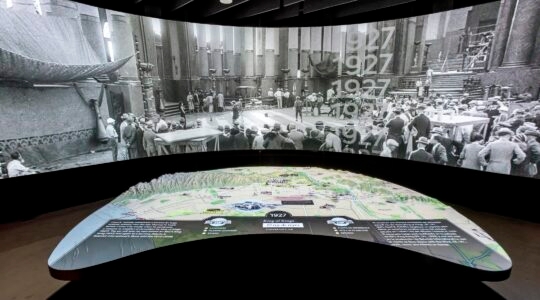(JTA) — In his historic 2016 run for president, Bernie Sanders was faulted for not having much of a foreign policy beyond reminding folks that his rival for the Democratic nomination, Hillary Clinton, had favored the Iraq War.
A key stumble in that campaign was a wide-ranging interview with the Daily News editorial board prior to the New York primary. The Daily News, then owned by Mort Zuckerman, wanted to hurt Sanders, and all it had to do was run the transcript in its entirety. Sanders was diffident, vague and not sure of his facts. He made a major error when he vastly overstated the number of Palestinians killed in the 2014 Hamas-Israel war, which got the Jewish candidate dinged by Jewish organizations.
The Independent senator from Vermont, 76, is considering another presidential run in 2020, and this time he’s making foreign policy a focus. Among issues where he has taken a lead: blasting President Donald Trump for pulling out of the Iran deal, calling for an end to support for Saudi Arabia in its bombing raids on Yemen — and offering tough criticism of Israel for how it’s responding to Palestinian protesters attempting to breach the fence with the Gaza Strip.
Sanders’ surprisingly effective challenge to Clinton as the flag bearer for the party’s left — he was the first Jewish candidate of a major party to win state primaries — and his focus on Israel is likely to spur more Israel-related debate within the party as the election approaches.
Since the launch of the protests in late March, Sanders’ office has posted three videos to social media criticizing Israel for what he deems is its excessive use of force and the Trump administration for not intervening. He brought up the Gaza protests at a foreign policy town hall he convened in Washington, D.C., that was meant to focus on Iran. The protests were also the centerpiece of his speech in April to the liberal Jewish Middle East policy group, J Street.
The left has taken notice. The liberal news site Mic noted that “Sanders has stood out for his forceful condemnation of the Israeli government’s actions and the U.S. response.” Jewish Voice for Peace, which supports a boycott of Israel, shared the video titled “Palestinians describe life in Gaza.” So did IfNotNow, a group for millennials who oppose the occupation.
Here are some takeaways:
What Sanders posts is less nuanced than what he says.
Sanders’ speech to J Street in April was familiar to anyone who has closely followed his pronouncements on Israel over the years: He was critical of Israel but added sympathetic caveats affirming its right to self-defense.
“Hamas, due to its ongoing repression, corruption and insistence on pursuing a violent struggle against Israel, bears significant responsibility for the deteriorating situation,” he said.
Sanders framed his criticism of Israeli Prime Minister Benjamin Netanyahu with expressions of affection for the country.
“As someone who believes absolutely and unequivocally in Israel’s right to exist, and to exist in peace and security, as someone who as a young man lived in Israel for a number of months and is very proud of his Jewish heritage … we must say loudly and clearly that to oppose the reactionary policies of Prime Minister Netanyahu does not make us anti-Israel.”
A social media video framed around the speech omitted all the affection. Seven minutes long, the video instead focuses on Israeli responsibility for the humanitarian crisis in Gaza, emphasizing Israel’s blockade and its troops’ use of live fire.
Another video, released Wednesday, dismisses out of hand Israeli claims that Hamas is responsible for the protests, saying instead that the demonstrations are an expression of grassroots activism. The claims of Hamas involvement, however, are not Israel’s alone — Hamas has made them. Reporting from the Gaza Strip suggests that as is often the case among Palestinians, authorities have assumed responsibility for protests that developed organically.
Sanders can be responsive to criticism …
The first video, released April 21, was lauded by the pro-Palestinian community and liberal pro-Israel activists, but there was criticism that most of the voices (grabbed in interviews at the J Street conference) were those of Israeli human rights activists. Where were the Palestinians?
A third video solely includes Palestinians speaking from the strip, with evocations of the hardship of living under siege. (One dramatic sequence includes a young woman speaking just as the lights go back on — Gazans get about four hours of electricity a day.)
… but he can still be tone deaf.
The second video, released after the deadliest day of riots, explained that “Gazans have been holding weekly protests at the fence demanding an end to the ten-year blockade, the occupation, and the right to return to their former homes in Israel.” That appeared to be an affirmation of the Palestinian claim that the descendants of refugees from Israel’s War of Independence have a claim on lands in Israel. Sanders’ staff explained that the video was merely stating Palestinian claims, not endorsing them.
Sanders gets in the weeds of the American Jewish debate and doesn’t like what he sees.
In his decades in Congress, Sanders was never one to engage deeply with what was happening in the broader national American Jewish community, which made sense for a senator from Vermont, where the tiny Jewish community has often steered clear of national Jewish politics.
These days he’s taking notice. The villains of his latest video are three New York Times columnists — Bari Weiss, Bret Stephens and Thomas Friedman — who in the video are accused of blaming the Palestinians for their own suffering. The three may not line up ideologically on Israel, but all fit well within the broad Jewish communal consensus on the Jewish state.
Sanders has been thinking a lot about Israel and Netanyahu and Trump.
The senator’s embrace of the Gaza issue is not merely a corrective to what for decades has been his overwhelming focus on domestic economic issues. Sanders has noticed a change in Israel and doesn’t like it; he really doesn’t like Israel’s coziness with the Trump administration. That was evident in the second video, which pointedly noted that the worst day of violence took place on the day the Trump administration opened the U.S. Embassy in Jerusalem, and juxtaposed video of Trump and Netanyahu.
It was also evident the same day at his town hall on Iran.
“It looks to me, not only of the events of today but just the actions of Israel over the last several years, plus the Trump administration repudiating the concept of a two-state solution, the growth of settlements, the kind of violence we saw today, what is going to happen in the future, when you have 2 million people in Gaza living in absolute desperation, 60 percent unemployment, what is going to be the future?” he said.
JTA has documented Jewish history in real-time for over a century. Keep our journalism strong by joining us in supporting independent, award-winning reporting.






